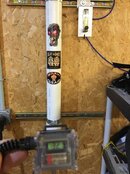scubapeter
Contributor
After years of partial pressure blending, I am looking to switch to a nitrox stick. I mostly use 32 percent so the pros of continuous blending outweigh the cons. I have two oxycheq expedition oxygen analyzers that I would like to use for continuous blending. Does anyone know of a way to remote the sensor from this particular analyzer? I have only used it with the sensor mounted inside of the unit. Looking to avoid any unnecessary purchases.
I am also interested to know if anyone has personal experience with using wiffle balls in lieu of the more traditional baffles. In theory, they would produce a great deal of turbulence.
My compressor is a Bauer Capitano, it does now and always has used synthetic oil. It has a p0 primary filter and a Lawrence Factor Hyper filter as a secondary.
Thanks in advance for your comments and opinions
I am also interested to know if anyone has personal experience with using wiffle balls in lieu of the more traditional baffles. In theory, they would produce a great deal of turbulence.
My compressor is a Bauer Capitano, it does now and always has used synthetic oil. It has a p0 primary filter and a Lawrence Factor Hyper filter as a secondary.
Thanks in advance for your comments and opinions





